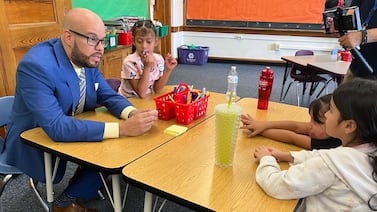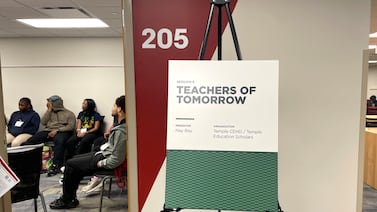Sign up for Chalkbeat Colorado’s free daily newsletter to get the latest reporting from us, plus curated news from other Colorado outlets, delivered to your inbox.
Colorado districts expect millions in cuts to what they anticipated receiving next year if changes proposed by Gov. Jared Polis make it into the 2025-26 budget.
Polis, who released his budget proposal on Nov. 1, has presented austerity measures due to the state facing an over half billion dollar budget hole.
His plan would increase school funding by about $115 million next year, bringing total spending to $9.8 billion. However, district leaders said that would be far less than what they are supposed to get, with school finance advocates calculating schools receiving about $190 million less next year if Polis’ changes are enacted.
The powerful six-member Joint Budget Committee, which does the majority of the work crafting the budget, would need to adopt his proposals. Committee lawmakers have expressed concerns.
And district leaders in the Metro area worry that Polis’ budget framework opens up the possibility for the state to find a new way to cut their budgets after lawmakers during the 2024 legislative session eliminated a practice this year that withholds money from schools for other priorities. District leaders say the changes would also exacerbate funding disparities and lead to harmful cuts for students, especially in districts grappling with declining enrollment.
Ultimately, the JBC and Colorado General Assembly will have the most say on how the state proceeds in terms of the budget, said Chuck Carpenter, Denver Public Schools chief financial officer. The district likely won’t see a major impact in funding cuts compared to other districts if the proposal goes through.
But the proposal makes budget planning difficult and, if passed, would fail to meet the promises made last year by lawmakers.
“This is just another way where K-12 is used to balance the budget,” Carpenter said.
District leaders hoped for stability in the 2025-26 budget
During the 2024 legislative session, school officials celebrated after lawmakers pushed to invest more in K-12 education.
Lawmakers eliminated the so-called budget stabilization factor after 15 years, which diverted constitutionally-mandated school funding for other priorities.
They also were able to approve a new school funding model that’s expected to boost state spending by $500 million. The law called for phasing the money in over six years and will better distribute state funding based on the types of students districts teach and help rural and smaller districts. The law also changed student enrollment counts from five to four years for the purpose of the budget.
Polis’ budget proposal tries to address an about $640 million budget shortfall next fiscal year, partly due to rising costs in Medicaid. At the same time, the state is limited by the Taxpayer’s Bill of Rights in how much revenue the state can keep.
His budget framework would change the student counts from the planned four-year average to a single year count. If lawmakers approve the change, this would have the biggest impact on schools with declining enrollment because averaging creates a multi-year buffer for them.
The governor also wants to slow the phase-in of the new school finance formula to seven years.
Jefferson County School District Superintendent Tracy Dorland said her district has made hard decisions to close schools as enrollment has declined. In Colorado, many districts have experienced enrollment declines.
Any funding change would cause even more disruptions for her students and families, she said.
“They need to leave things alone for a minute so that we have some clarity and some stability in our revenue models,” Dorland said.
In proposing the change, Polis has pointed to the majority of states that use one-year counts. He also said his proposal would fend off any return to using the budget stabilization factor.
Nationally, since the pandemic, some states have started to do the opposite of what Polis has proposed, according to Christopher Duncombe, Education Commission of the States principal, who is a school finance expert.
He said a few states have opted to blend enrollment across multiple years to protect districts with declining enrollment from financial losses. For example, California allows districts to choose between a one-year count or a three-year average.
Tracie Rainey, Colorado School Finance Project executive director, added a change would also pull money away from schools during a time when the state is still awaiting a study that shows how much schools need to adequately educate students.
Her analysis shows the $191 million cuts would unevenly impact districts, with some receiving a 33% cut in what they expected while others would see zero impact.
“It’s not bringing back the budget stabilization factor, but in all essence, it’s a cut to K-12,” she said.
Polis’ proposal sparks district and lawmaker concern
On Wednesday, during a presentation from Polis, budget lawmakers shared reservations about enacting his plan. The Joint Budget Committee does the bulk of the work to craft the budget.
Sen. Barbara Kirkmeyer, a Weld County Republican, said she was finding it difficult to take Polis’ budget seriously because it doesn’t keep the promises made by the legislature in the last year.
“I’m very disappointed that it looks like we’re actually cutting funding to K-12 education,” Kirkmeyer said.
Dorland said her district would get about $23 million less under this proposal.
“And this is after, since 2009, $10 billion that has been withheld from Colorado public education,” she said. “The JBC really needs to think about how removing averaging will impact districts across the state and the impact we’ve already had over the last decade.”
Cherry Creek School District Chief Financial and Operating Officer Scott Smith said although his district didn’t experience enrollment declines this year, the elimination of averaging would still impact his district by about $10 to $15 million.
“We’ve shortchanged a generation of kids,” Smith said. “We should be doing everything we can to not allow that to happen again.”
Meanwhile, Chris Gdowksi, Adams 12 superintendent, said three Adams County districts, including his, are some of the lowest-funded in the Metro area and his district would get about $13.8 million less than expected. Other districts in the area have a buffer because they raise more local property tax dollars for schools.
Changes to the state budget are felt more acutely in the three districts because of low property tax wealth, he said.
For Adams 12, Gdowksi said he might have to cut positions such as support staff, hold off on crucial raises in a district that has struggled to stay competitive with the surrounding area, and increase class sizes.
Gdowksi said funding for public education needs a long-term solution. He, like other district leaders, said he would like to see a bipartisan-backed statewide ballot measure to raise more funding for schools. And he’s hopeful lawmakers will find a different way to balance the budget in the short-term.
“I am hopeful that folks can lean in and find a different way,” Gdowski said. “There are different and better ways to get there.”
Jason Gonzales is a reporter covering higher education and the Colorado legislature. Chalkbeat Colorado partners with Open Campus on higher education coverage. Contact Jason at jgonzales@chalkbeat.org.






